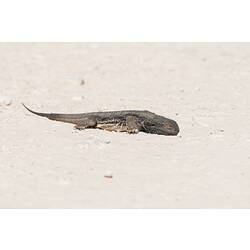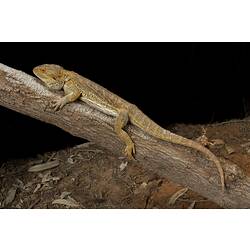General Description
Body with lines of ordered spines on the sides between the front and hind legs. Barbed scales under the chin form a 'beard'. Up to 25 cm long (snout-vent).
Biology
Central Bearded Dragons are active during the day, eating insects, small lizards, fruits and flowers. They are semi-arboreal, often seen sitting up on dead vegetation, on spinifex grass hummocks or up in small trees. Females lay up to 25 eggs in a clutch. Like the Bearded Dragon, they will often flee to a nearby burrow under a pile of dead vegetation when disturbed and will spread their spiny beards to reveal a pink inner mouth when they are threatened.
Distribution
Central and eastern mainland Australia.
Habitat
Dry areas including woodlands.
More Information
-
Animal Type
-
Animal SubType
-
Brief Id
Spines in rows along side of body, spiny 'beard' below neck.
-
Colours
Brown, Yellow
-
Habitats
-
Diet
Carnivore
-
Diet Categories
Insects, Invertebrates
-
Endemicity
-
Conservation Statuses
CITES: Not listed, FFG Threatened List: Not listed, EPBC Act 1999: Not listed, IUCN Red List: Least Concern
-
Taxon Name
-
Scientific Author
(Ahl, 1926)
-
Common Name
Central Bearded Dragon
-
Kingdom
-
Phylum
-
Subphylum
-
Class
-
Subclass
-
Order
-
Suborder
-
Infraorder
-
Family
-
Genus
-
Species Name
vitticeps


























